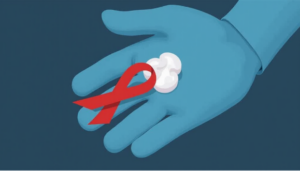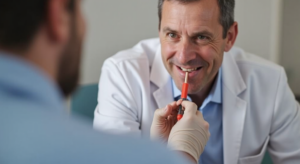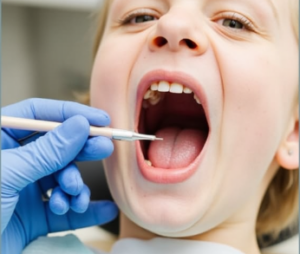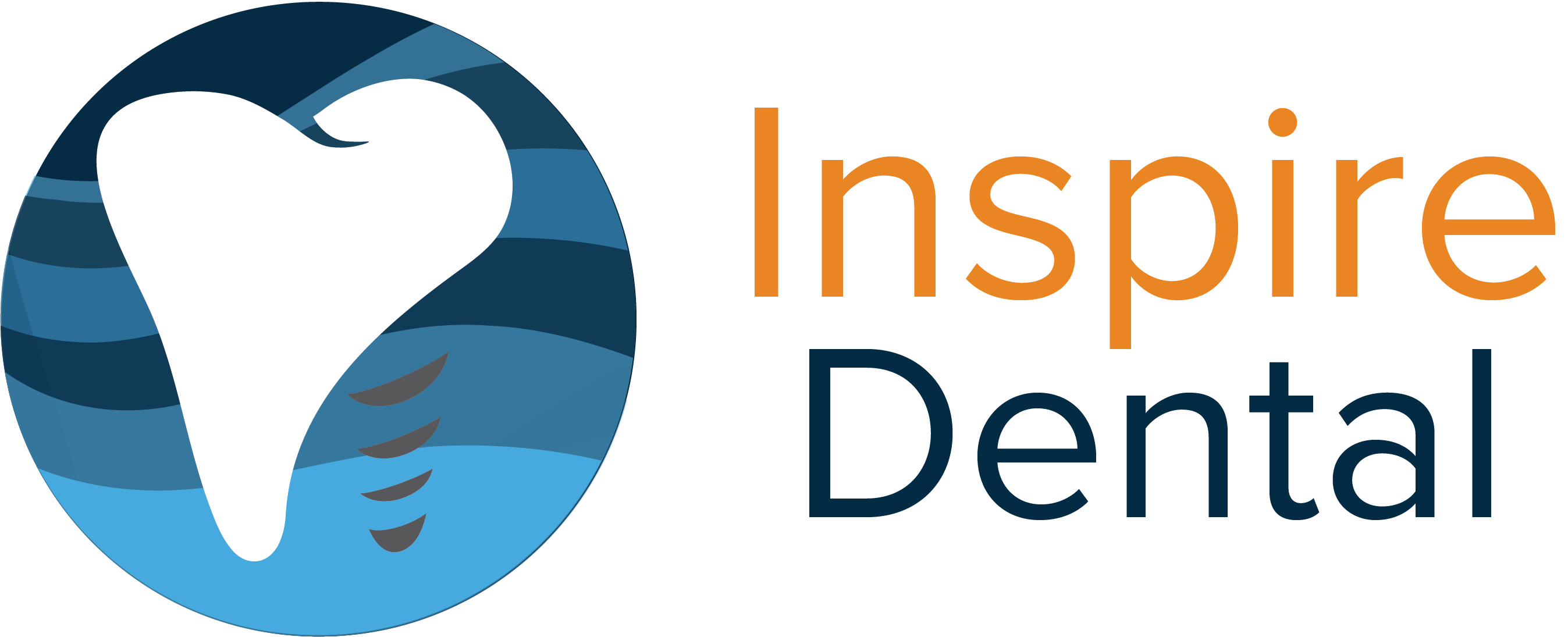Oral cancer screenings are a quick, painless examination performed by dentists to check for signs of cancer or precancerous conditions in your mouth. These screenings are an essential part of regular dental check-ups and can help detect oral cancer in its early stages when it’s most treatable.
Key takeaways
- Oral cancer screenings are simple, non-invasive exams performed during routine dental visits
- Early detection through screenings can significantly improve treatment outcomes
- Risk factors include tobacco use, heavy alcohol consumption, and HPV infection
- Screenings involve visual and physical examination of the mouth, throat, and neck
- Regular dental check-ups that include oral cancer screenings are crucial for overall health
Understanding Oral Cancer Screenings and Its Impact

Oral cancer is a serious health concern that affects thousands of Americans each year. It can develop in various parts of the mouth, including the lips, tongue, cheeks, floor of the mouth, hard and soft palate, sinuses, and throat. Despite its prevalence, many people are unaware of the importance of regular screenings for this potentially life-threatening condition.
The silent threat of oral cancer
One of the reasons oral cancer is so dangerous is that it often goes unnoticed in its early stages. Many people don’t experience pain or obvious symptoms until the cancer has progressed. This is why regular screenings are so important – they can catch potential issues before they become more serious.
Risk factors for oral cancer
While anyone can develop oral cancer, certain factors can increase your risk. These include:
- Tobacco use (smoking or chewing)
- Heavy alcohol consumption
- Prolonged sun exposure to the lips
- Human papillomavirus (HPV) infection
- A diet low in fruits and vegetables
- A weakened immune system
Understanding these risk factors can help you make informed decisions about your lifestyle and health choices.
The Importance of Early Detection

Early detection is key when it comes to oral cancer. When caught early, the survival rate for oral cancer is significantly higher than when it’s discovered in later stages. This is why regular screenings are so crucial.
Survival rates and early detection
The five-year survival rate for oral cancer when detected early is around 84%. However, this rate drops dramatically to about 65% when the cancer has spread to surrounding tissues or lymph nodes, and to just 39% when it has spread to distant parts of the body.
The role of dental professionals
Dentists and dental hygienists play a crucial role in early detection. They are often the first healthcare professionals to notice signs of oral cancer during routine check-ups. This underscores the importance of regular dental visits, even if you’re not experiencing any obvious dental problems.
What to Expect During an Oral Cancer Screening

Oral cancer screenings are typically quick and painless. They’re usually performed as part of your regular dental check-up, so you might not even realize you’re being screened.
Visual examination
Your dentist will visually inspect your face, neck, lips, and the inside of your mouth. They’ll look for any asymmetries, swellings, bumps, patches of color, or ulcerations.
Physical examination
In addition to the visual check, your dentist will feel the tissues in your mouth and the external areas of your neck and jaw. They’re checking for any unusual masses or nodules.
Additional diagnostic tools
Some dentists use additional tools to aid in screening. These might include:
- Special lights that can highlight abnormal tissues
- Dyes that can make abnormal cells more visible
- Oral cancer screening rinses
These tools can help dentists spot potential issues that might not be visible to the naked eye.
Signs and Symptoms to Watch
While regular screenings are important, it’s also crucial to be aware of potential signs and symptoms of oral cancer. If you notice any of these between dental visits, it’s important to get checked out:
- Persistent sores or irritations in the mouth that don’t heal
- Red or white patches in the mouth
- Pain, tenderness, or numbness in the mouth or lips
- A lump, thickening, rough spot, crust, or small eroded area
- Difficulty chewing, swallowing, speaking, or moving your jaw or tongue
- A change in the way your teeth fit together when you close your mouth
Remember, these symptoms don’t necessarily mean you have cancer, but it’s always better to get them checked out.
The Screening Process: What Happens Next?
If your dentist finds something suspicious during a screening, don’t panic. Many abnormalities turn out to be harmless, but further testing may be necessary to be sure.
Follow-up procedures
If an area of concern is identified, your dentist might:
- Recommend a follow-up visit to see if the suspicious area has changed
- Perform a biopsy (taking a small sample of tissue for laboratory analysis)
- Refer you to a specialist for further evaluation
It’s important to follow through with any recommended follow-up procedures to ensure any potential issues are addressed promptly.
The Role of Lifestyle in Oral Cancer Prevention
While regular screenings are crucial, lifestyle choices play a significant role in oral cancer prevention. Here are some steps you can take to reduce your risk:
Quit tobacco
Tobacco use, whether smoking or chewing, is one of the biggest risk factors for oral cancer. Quitting can significantly reduce your risk.
Limit alcohol consumption
Heavy alcohol use is another major risk factor. If you drink, do so in moderation.
Protect your lips from sun exposure
Use lip balm with SPF and limit direct sun exposure to your lips.
Eat a healthy diet
A diet rich in fruits and vegetables can help protect against oral cancer.
Practice good oral hygiene
Regular brushing, flossing, and dental check-ups can help maintain overall oral health.
Oral Cancer Screenings for High-risk Individuals
Some people may need more frequent or thorough screenings due to their higher risk of developing oral cancer.
Who is considered high-risk?
High-risk individuals might include:
- Heavy tobacco users
- Heavy alcohol users
- Those with a history of oral cancer
- People with certain genetic predispositions
If you fall into a high-risk category, talk to your dentist about how often you should be screened and if any additional screening methods might be beneficial for you.
The Psychological Aspect of Oral Cancer Screenings
It’s normal to feel anxious about cancer screenings of any kind. However, it’s important to remember that screenings are a proactive step towards maintaining your health.
Dealing with screening anxiety
If you’re feeling anxious about oral cancer screenings, consider these tips:
- Talk to your dentist about your concerns
- Bring a friend or family member to your appointment for support
- Practice relaxation techniques like deep breathing
- Remember that screenings are quick and painless
The peace of mind factor
Regular screenings can provide peace of mind. Knowing that you’re taking proactive steps to protect your health can help alleviate anxiety about oral cancer.
Oral Cancer Awareness: Spreading the Word
Increasing awareness about oral cancer and the importance of screenings is crucial. Many people are unaware of the risks of oral cancer or the importance of regular screenings.
Community outreach and education
Dental practices can play a role in community education by:
- Participating in oral cancer awareness events
- Providing educational materials in their offices
- Using social media to share information about oral cancer and screenings
Encouraging others to get screened
You can help spread awareness by encouraging friends and family to get regular dental check-ups that include oral cancer screenings.
The Future of Oral Cancer Screening
As technology advances, so do the methods for detecting oral cancer. Researchers are continually working on developing new, more effective screening tools.
Emerging technologies
Some promising developments in oral cancer screening include:
- Advanced imaging techniques
- Saliva-based tests
- AI-assisted screening methods
While these technologies are exciting, it’s important to remember that they’re meant to complement, not replace, traditional screening methods.
Oral Cancer Screenings: A Small Step with a Big Impact
Oral cancer screenings are a simple yet powerful tool in the fight against oral cancer. They’re quick, painless, and can potentially save lives.
Making screenings a priority
By making oral cancer screenings a regular part of your dental care routine, you’re taking an important step in protecting your overall health. Remember, early detection is key, and regular screenings are the best way to catch potential issues early.
A call to action
If it’s been a while since your last dental check-up, now is the time to schedule one. Feel free to visit our website or contact us now to take the first step towards a healthier, more active lifestyle! Ask your dentist about oral cancer screenings and make sure they’re a part of your regular dental visits. Your health is worth it.
| Screening Method | Description | Advantages |
|---|---|---|
| Visual Examination | Dentist visually inspects the mouth and throat | Quick, non-invasive, can detect visible abnormalities |
| Physical Examination | Dentist feels tissues for lumps or abnormalities | Can detect issues not visible |
| Fluorescence Visualization | Special light used to highlight abnormal tissues | Can detect abnormalities not visible under normal light |
| Brush Biopsy | Cells collected from suspicious areas for lab analysis | Minimally invasive, can provide definitive diagnosis |
| Risk Factor | Relative Risk Increase |
|---|---|
| Tobacco Use | 5-10 times |
| Heavy Alcohol Use | 3-9 times |
| HPV Infection | 32 times |
| Prolonged Sun Exposure | 2-3 times |
| Poor Diet (low in fruits/vegetables) | 2-3 times |
- Steps to reduce oral cancer risk:
- Quit tobacco use
- Limit alcohol consumption
- Use sun protection on lips
- Eat a diet rich in fruits and vegetables
- Practice good oral hygiene
- Get regular dental check-ups with oral cancer screenings
- Know the signs and symptoms of oral cancer
- Get vaccinated against HPV
